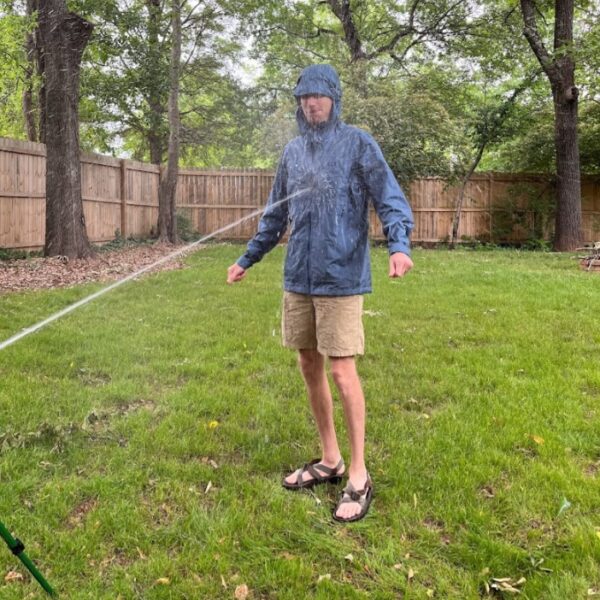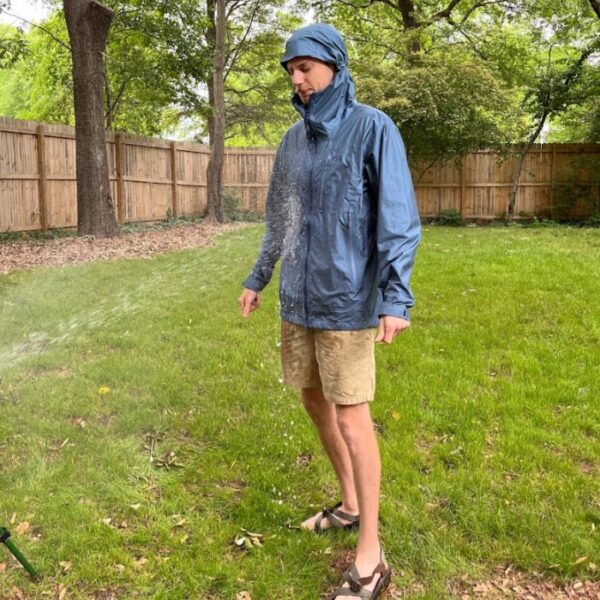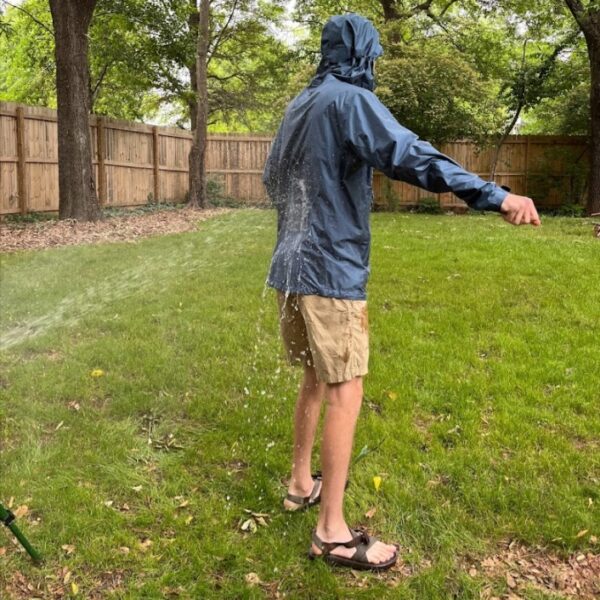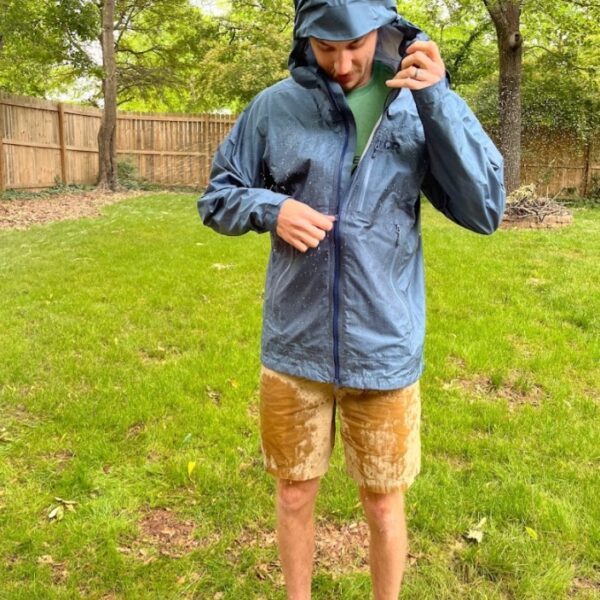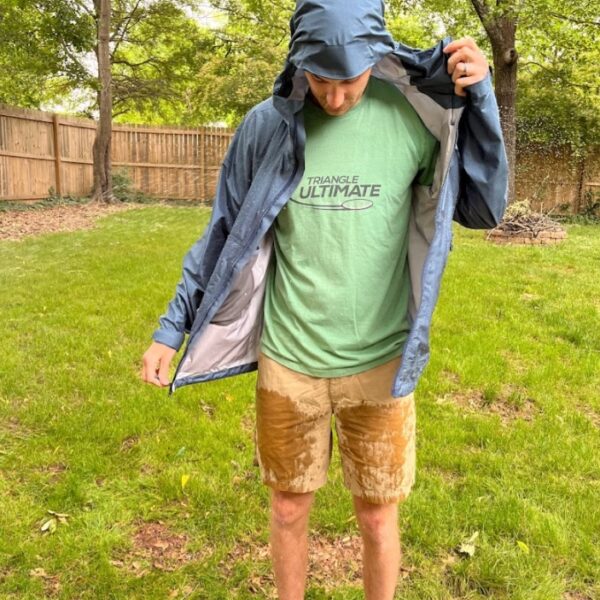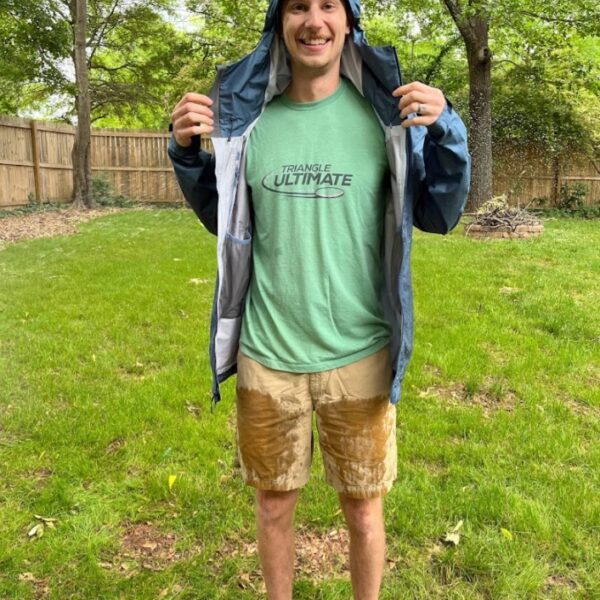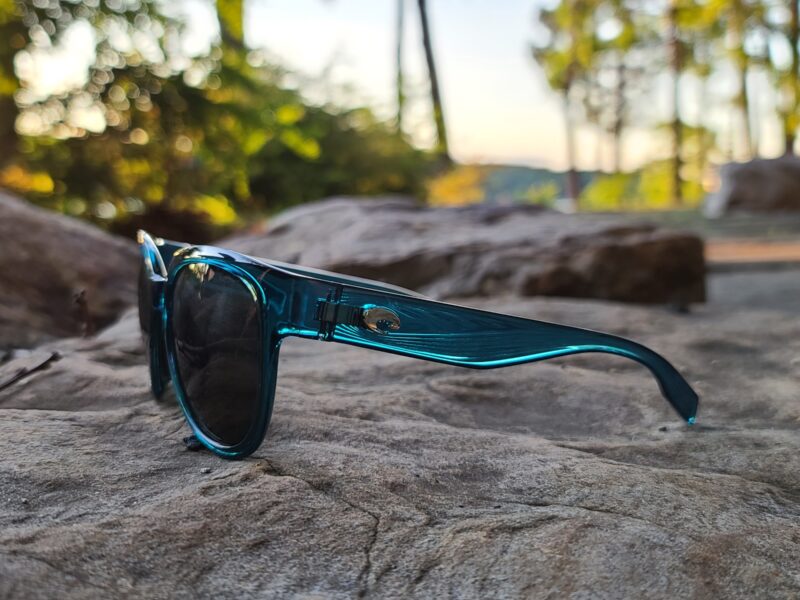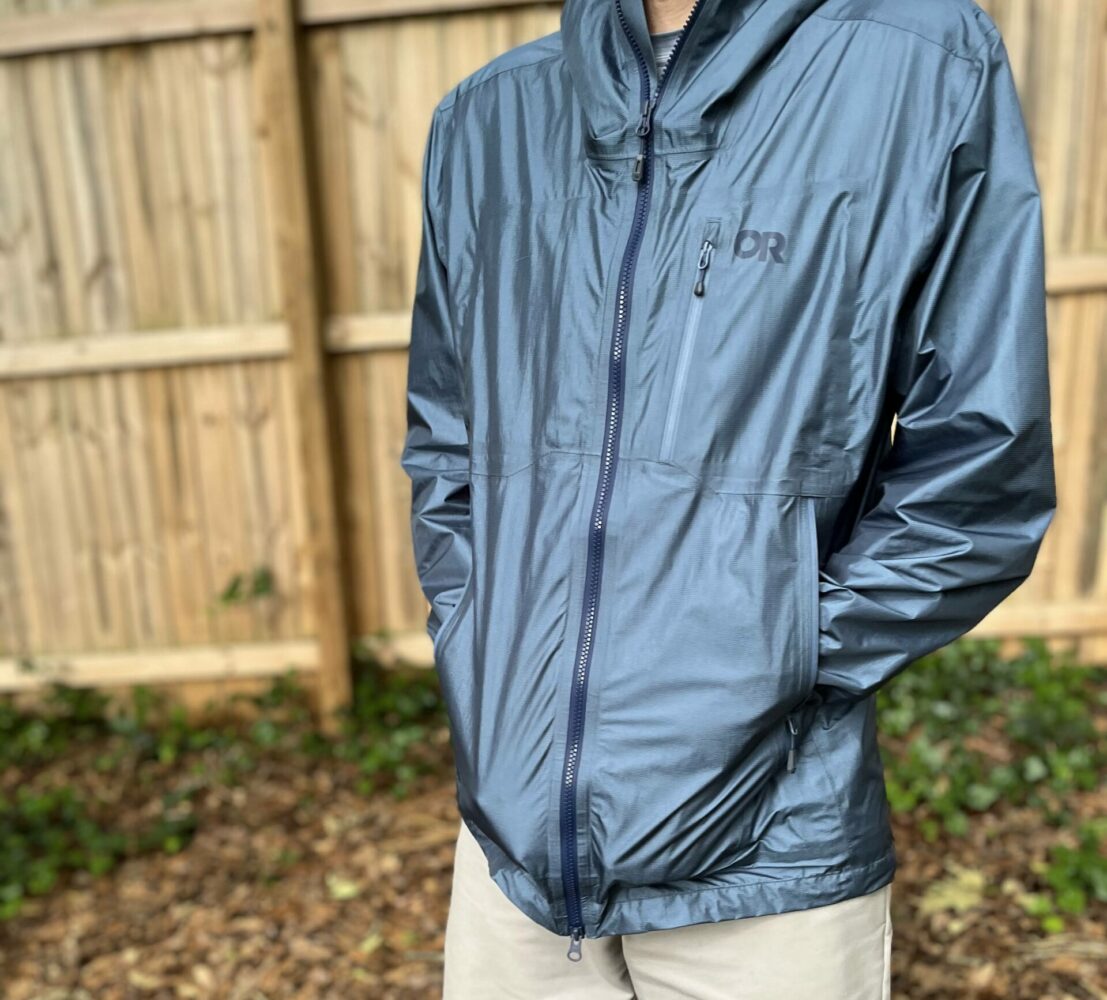
Outdoor Research Helium AscentShell Rain Jacket Review
The Helium AscentShell Rain Jacket is the latest rain jacket from Outdoor Research. It follows its predecessor, and the most popular Outdoor Research rain jacket to date, the Helium Rain Jacket. I wanted to put the Helium AscentShell Rain Jacket to the test for what we do, which is fishing in the rain. We’ll answer three simple questions. Will it keep you dry? Is it breathable? Is it worth the cost?
- Price: $399
- Water Resistance Testing: more than 15,000mm (JIS L 1092 B taffeta cover)
- Moisture Vapor Transfer: more than 20,000g/m2 (JIS L 1099 B-1)
- DWR Rating: 80/20
Will The Helium AscentShell Rain Jacket Keep You Dry?
Short answer – a resounding yes. This jacket has been tested in the most extreme conditions – like the world’s second highest mountain K2. Our tests were … a little less extreme. My wife sprayed me with a hose while I held a fishing pole, and I went fishing at a pond while it was raining. Who’s to say which one is more extreme?
To be fair, we weren’t testing this for mountain climbing, we were testing this for fishing in the rain, so we thought that tests were perfect. In order to jump into our test, let’s first learn more about the material the Helium AscentShell Rain Jacket is made out of.
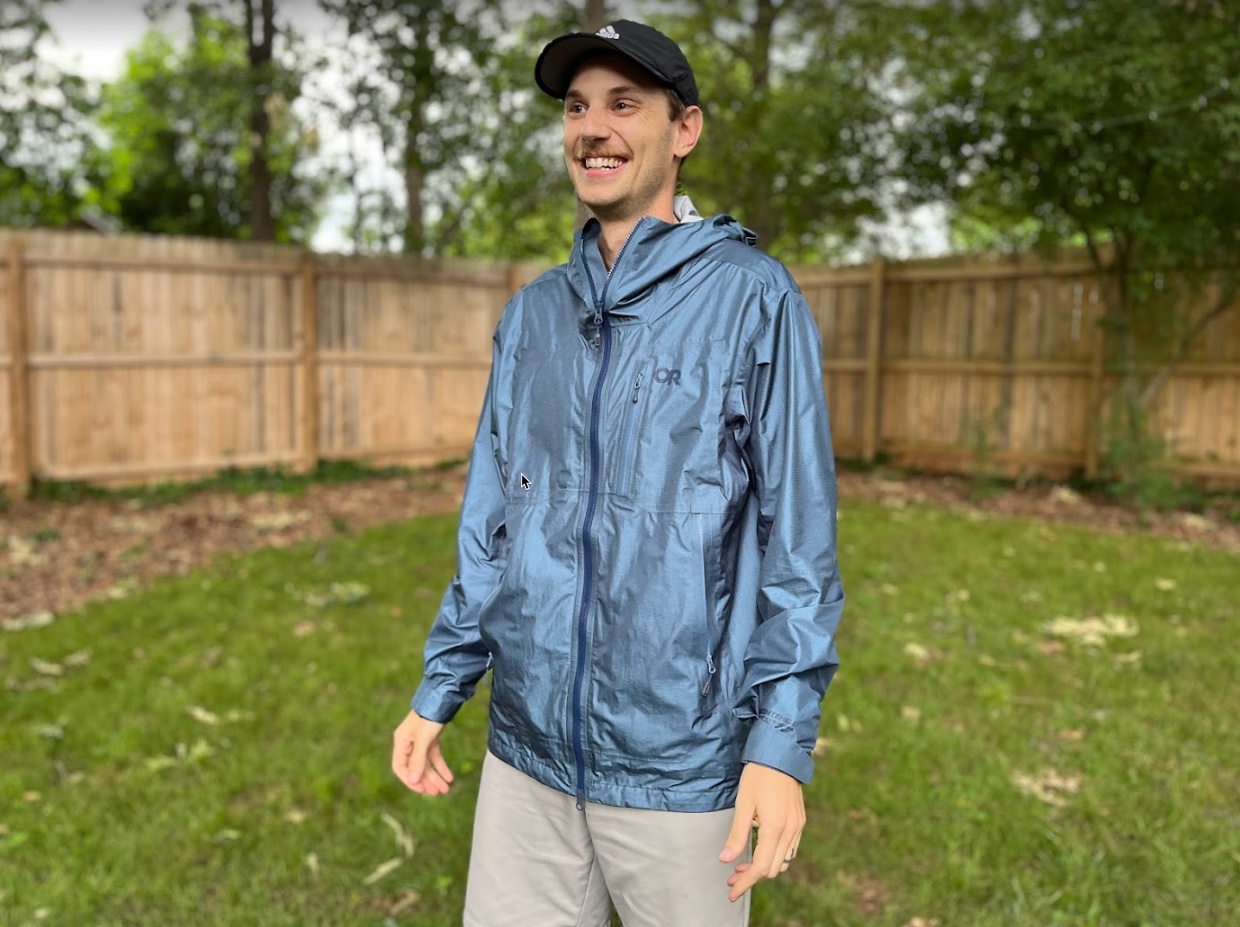
Materials, Construction, and Coatings
This section contains the high tech science behind this fabric. Feel free to read through it because it’s really interesting. Or you can skip down below the italics if you get bored.
The Helium AscentShell Rain Jacket is made with Pertex® Diamond Fuse fabrics and AscentShell. Those are two incredible things that when combined make an incredible rain jacket. But let’s learn more about them.
Pertex® Diamond Fuse fabrics use yarns with unique diamond shaped filaments. These filaments lock together to create a durable and highly abrasion resistant fabric. This engineered structure allows Diamond Fuse fabrics to remain very stable over extended wear and washing.
AscentShell is an Outdoor Research exclusive, proprietary fabric that’s a waterproof, breathable three-layer fabric that broadens your comfort zone during aerobic effort throughout changing conditions. It’s created by an electrospinning process where charged polymers are affixed to a grounded surface. Those polymers gather into a breathable membrane that, under a microscope, you can see forming a web that allows sweat vapors out but stops water from coming in.
One important difference between electrospun (nanospun) waterproof jackets and traditional waterproof jackets is that electrospun products are air permeable. Air permeability is when a small amount of airflow allows moisture to move quickly and easily from the inside of the jacket to the outside, before building up to sweat levels that create discomfort and clamminess. As a result, air permeable jackets are going to make you a lot more comfortable when you’re active than “waterproof breathable” jackets.
Alright, so we have read through the scientific and research fabrics that this incredible rain jacket is made out of. Now let’s boil that down a little more to how an Outdoor Research employee explained it:
“Think of electrospun membranes like cotton candy done on a microscopic level. It is made from very small polyurethane short-staple fibers that are electrically charged and then randomly laid to create a waterproof barrier that is actually air-permeable.”
Now let’s boil it down one more time to what you really care about – is it waterproof? Below you can see me getting sprayed by a sprinkler wearing the Helium AscentShell Rain jacket. And here is my shirt afterwards. Dry.
Is the Helium AscentShell breathable?
So we’ve settled that this is indeed a waterproof rain jacket. But what about breathability? Outdoor Research says it has a Moisture Vapor Transfer or more than 20,000g/m2 (JIS L 1099 B-1). That’s the scientific number, but let’s go into testing.
To test breathability, I had to do something I don’t like doing – running in a rain jacket. Now this is different for everyone because everyone sweats at different temperatures. But for me, the AscentShell rain jacket passed with flying colors. Also, we’re testing this rain jacket for fishing in the rain. The main times I sweat when I’m fishing in the rain is when I’m kayaking or when I am running away from a water moccasin. I think more importantly, this rain jacket keeps you cool even when it’s hot outside. That’s what I was looking for.
Is the Helium AscentShell worth the cost?
So you may be thinking, “alright sweet, this is obviously a great rain jacket. But it’s more expensive than some of the other rain jackets.” You’d be right, it’s not a cheap rain jacket.
Here’s all I will say. This is a rain jacket you will most likely use for the rest of your life and perhaps the best rain jacket on the market right now.
That’s why it’s an expensive rain jacket. Consider these two scenarios. 1) You’re fishing in the rain and getting wet because your rain jacket is only water resistant and you’re wet because you’re sweating under a rain jacket that isn’t breathable. But you saved a little money. 2) You’re dry and comfortable sitting in the rain continuing to catch fish because you spent the extra money to buy a rain jacket that actually does its job. Also you never have to buy another rain jacket.
Do we recommend the Helium AscentShell rain jacket for fishing?
Yes, absolutely. It’s waterproof, breathable, durable and light enough to pack in your bag. There is an initial investment with the cost, but just like buying nice polarized sunglasses over cheap lenses. You’ll ultimately save money in the long run because you won’t have to buy another rain jacket again for the foreseeable future. Their warranty is also top of the line!
Outdoor Research® gear is guaranteed to perform throughout the lifetime of the product. Get your gear back on track by filing a claim on our Warranty Page.
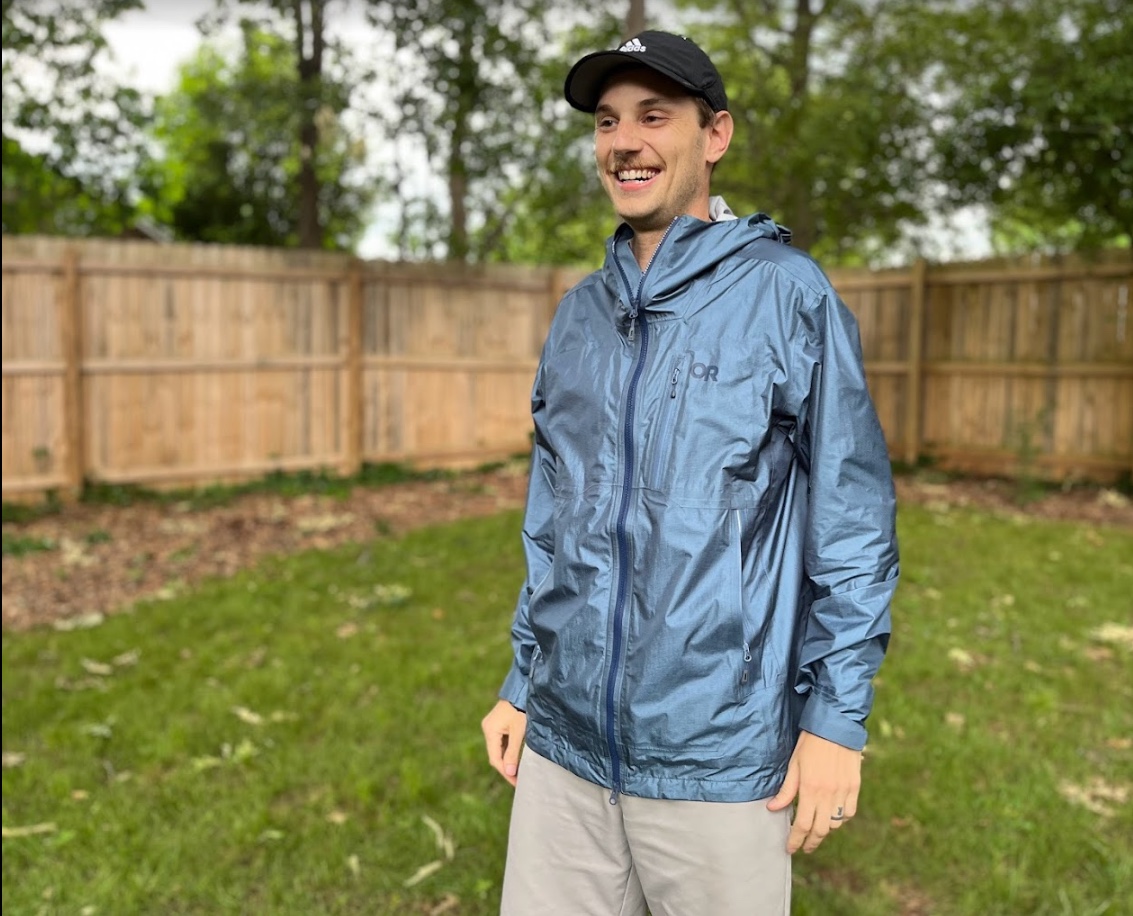
Learn More about Fishing Rain Gear Basics
What Does “Waterproof” Really Mean?
The terms waterproof, water resistant, and weatherproof are all thrown around a lot in the outdoor industry and it creates confusion for consumers. This is beneficial for manufacturers that are not using high quality waterproof materials. Waterproof material is really more of a spectrum than anything else. There is an agreed upon standard in the industry to use the height in millimeters as a rating of the materials resistance to water penetration when a one inch wide tube is filled with water and placed on it. This is how rain jacket and tent waterproofing is graded and this is how you get odd sounding numbers like 15,000mm waterproofness. These values can also be converted into PSI values where 704mm = 1 PSI. You do the math.
In reality 15,000mm means is that the Outdoor Research Helium AscentShell Rain Jacket can handle the pressure generated from putting over 49 feet of water on it in a one inch tube. I suppose this type of a test makes sense for waterproofing due to standard psi values that are consistent across testing, but it just seems so weird and I can’t get the image of a bunch of people pouring a crap ton of water into a tube that’s taller than most apartment complexes out of my head. (I know in reality they likely use a calibrated pressure tool, but I like the big tube better). What you should also look out for is the testing for waterproof values applies to the fabric only. So if a fabric is entirely waterproof, the seams must be sealed or taped and the zippers must have storm flaps. If not, you could still be getting wet.
A GUIDE ON WATERPROOF MEASUREMENTS
0-5,000mm: This has almost no resistance to moisture, it will handle light rain.
6,000-10,000mm: This is rainproof and waterproof under light pressure such as light rain and light snow.
11,000-15,000mm This is rainproof and waterproof except under high pressure such as moderate rain and normal snow.
16,000-20,000mm: This is rainproof and waterproof under high pressure such as heavy rain and wet snow.
20,000mm+: This is rainproof and waterproof for driving rain and wet snow.
Q: So is 15,000mm a good rain jacket rating?
A: Well in general for outdoor rain jackets you want to have a minimum of 15000mm of waterproofing, and the US military requires a spec of 16,700mm however a bigger number isn’t necessarily better in all cases.
Q: Wait…what?
A: A higher waterproofing rating doesn’t always translate into better durability. The more coating or material you use, the heavier and more rigid the fabric becomes which can cause it to become more prone to tearing.
Q: So you have to find a perfect blend of material that is very waterproof and isn’t too rigid?
A: Exactly, which is why there is so much technology that goes into the development of these rain jackets.
Q: Makes perfect sense, but why not use a rubber or plastic raincoat? Water will never get through those and they’re very durable!
A: Yes, but now we need to talk about breathability
What Does “Breathable” Really Mean?
Breathability is the ability of a material to allow moisture in the form of sweat vapor to leave the rain jacket while keeping out the rain at the same time. This seems like a paradox, however it is actually possible with technology developed by top outdoors companies. Breathability is measured in grams per square meter over 24 hours (g/m²/24hr). At a very high level this is achieved through layering materials and creating a hydrophobic coating that makes water molecules bind together and roll off the exterior, while allowing the sweat vapor inside to escape through the tiny pores in the material because it is attracted to the colder and relatively drier air outside. It is so much more complex than that, but I am not nearly qualified enough to explain it all.
Why do you want a rain jacket to be breathable? For the simple reason that you’re wearing it in the first place, to stay dry! If you have ever worn an old rubber rain coat or waders then you know that they work great at keeping out water, but when you go to take it off you’re as wet and clammy as if you hadn’t even been wearing it in the first place. That is all because your sweat vapor had nowhere to escape since rubber isn’t breathable.
Ultimately if you’re targeting a rain jacket for high activity such as hiking or kayaking then it must be very breathable and flexible. Otherwise you will be clammy and damp.
Wesley Anderson
Wesley lives in Georgia and has spent the last 30 years hiking, camping, and fishing. Wesley has been in the fishing online industry since 2011 and loves sharing his knowledge of fishing products and fishing techniques. In order to give readers hands on knowledge, we've put hundreds on products to the test.
All stories by: Wesley Anderson


